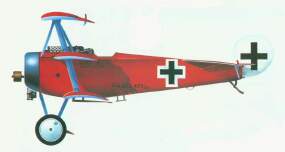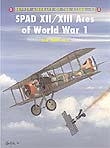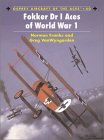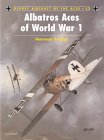AcePilots Main Page
WWI Aces

They fought in canvas and wood biplanes that could barely fly 100 MPH. Men like von Richthofen, Rickenbacker, Bishop, Guynemer, Mannock, Ball, who flew airplanes with names like Spad, Fokker, Albatros, Nieuport, and Sopwith Camel.
In this era, the top speeds were about 100 MPH. When the pilots ventured ten miles over the enemy lines, that was a notable event. The pilots carried no parachutes. The airplanes were made of wood and canvas; when they caught on fire, it spread quickly, and spelled certain death for the occupants.
The press and public, desperate for heroes amongst the waste and destruction of the trenches, idolized the young heroes.
Notable Aviators
German
Oswald Boelcke - 40 victories
Herman Göring - 22
Max Immelmann - early German ace, 15
Manfred von Richthofen - The Red Baron, 80
Ernst Udet - 2nd highest German ace, 62
American
James Norman Hall - flier and novelist
Raoul Lufbery - American volunteer, 17
Frank Luke - The Balloon Buster, 18
Billy Mitchell - airpower advocate
Capt. Eddie Rickenbacker - America's top ace, 26
The Lafayette Escadrille - Americans with French Air Service
 First Pursuit Group History in 1918 - Records of the 17th, 27th, 94th, 95th, and 147th Squadrons.
Part 2,
Part 3,
Part 4,
Part 5 First Pursuit Group History in 1918 - Records of the 17th, 27th, 94th, 95th, and 147th Squadrons.
Part 2,
Part 3,
Part 4,
Part 5
Americans with British R.F.C.
- Fred Gillet - 20 victories; Sopwith Dolphin pilot
- Wilfred Beaver - 19; Brisfit pilot
- David Ingalls - 6; Naval aviator
- Field Kindley - 12
- Reed Landis - 12
- Fred Libby - 14; cowboy, first American ace
- O.C. "Boots" LeBoutillier - 10; taught Amelia Earhart
- Elliott Springs - 16
British Empire
Albert Ball - Britain's first great ace, 44 kills
Billy Barker - Canadian, Sopwith Camel pilot, VC; 50
Billy Bishop - Canada's leading ace, 72
Ray Collishaw - Canadian, RNAS Triplane pilot, 62
Lanoe Hawker - "the British Boelcke," winner of Victoria Cross
Edward "Mick" Mannock - Britain's highest-scoring ace, 61
James McCudden - 57, Victoria Cross
French
René Fonck - Top Allied ace, 75
Roland Garros - first French ace
Georges Guynemer - 53 victories
Charles Nungesser - 43
Other
Anthony Fokker - Dutch aircraft designer
This is not a complete list. See The Aerodrome for a comprehensive list of WWI aces.
|
Great Aircraft
German
Albatros D.II/D.III - late 1916
Fokker Dr.I Triplane - 1917, the Red Baron's famous aircraft
Fokker D.VII - 1918, one of the best
Fokker D.VIII - late 1918, high-wing monoplane
Fokker E.III - mid 1915, synchronized machine gun
British
D.H. 2 - early 1916, pusher biplane
F.E. 2b - early 1916, pusher biplane
S.E.5a - mid 1917, one of the best
Sopwith Camel - mid 1917
Bristol F.2B Fighter "Brisfit" - excellent two-seat fighter
French
Moraine-Saulnier L - April, 1915, the first fighter
Nieuport 11 - early 1916, small scout, wing-mounted Lewis gun
Nieuport 17
Nieuport 28
Spad S.VII
Spad S.XIII - mid 1917, one of the best
Observation Balloons

Buy 'Spad XII/XXIII Aces
of World War I'
at Amazon.com
|
Victory Credits
The subject of aerial victories, "kills," or "official credits" has always been controversial. The confused and stressful circumstances of aerial combat have never permitted absolute certainty. (Even the use of gun cameras didn't make for certainty; in Korea, three visible tracer strikes on a MiG counted as a kill.)
In the First World War, aerial combat was all new, too new for clear rules to have been established. One of the first British aces, Lanoe George Hawker, may have shot down over fifty aircraft, but in those early days, the British kept no records of aircraft destroyed. And once they did begin, they gave credit somewhat indiscriminately; the categories of "shared," "probable," and "damaged" were not widely used until WWII. (The Aerodrome website has attempted to revise the British records using these concepts.)
Of course, the pilots themselves usually felt that their official credits under-stated their actual kills. The leading French ace, Rene Fonck, credited with 75 kills, personally claimed 126. In other cases, official recognition was withheld from NCO's; only commissioned officers were so credited.
Frederick Libby, an American who flew with the British, claimed ten as an NCO observer/gunner, but these were not officially added to the fourteen he scored as an officer and pilot. And so it goes; in all likelihood, the claims will never be resolved, especially now we are the better part of a century removed from that time.
All the credits for aerial victories noted here are the "official" numbers, as reported in various secondary sources. (Even some of those vary and I usually opted for the lower figure.) Perhaps a better term than "official" would be "traditional."
Whether Manfred von Richthofen shot down precisely 80 airplanes, Guynemer 53 (or 54?), Billy Bishop 73, Mick Mannock 61, and Frank Luke 21 (or 19?), does not matter too much any more. They were great fliers in an almost legendary era. Their heroism and their achievements go beyond precise enumeration of aircraft destroyed.
Conditions of Aerial Combat
On the Western Front, the British and French air force outnumbered the Germans during World War One. Together they produced 125,000 aircraft, while the Germans built less than 50,000. With these superior numbers, the Allies were generally able to take the fight to the Germans, bombing and reconnoitering over their lines.
This fundamental aspect of WWI's air war meant that German fighter pilots usually flew over their own terrain, which required less fuel, less flying time, and also easier confirmation of downed aircraft. An added bonus for the German jagdflieger was the prevailing west wind. Any crippled German plane gliding for home had the wind at its back; while any damaged Allied plane faced head winds. Not a small consideration for the light craft of those years. Thus while the Allies' greater numbers gave them the edge in the air war, many German aces were able to rack up impressive scores of downed British and French planes.
Aircraft Milestones
In the first few months of the war, combat between airplanes was unknown; they were used for observation and some far-sighted aviators could envision using them for bombing. After some pilots took up pistols and rifles, some planes had machine guns mounted in the observer's seat, which typically fired rearward or to the side. When a French pilot, Roland Garros, bolted steel deflectors to his propeller, which permitted him to fire a machine gun through it, the airplane became an offensive weapon.
Then Tony Fokker, a Dutch airplane builder and entrepeneur working for the Germans, installed interrupter gear, permitting a machine gun to fire through the prop with much more reliability. For a time, the Fokkers gave the Germans an edge.
Over the course of the war, the quality of Allied fighters, or "scouts," generally matched the Germans.
The quality advantage swung back and forth somewhat, but even the mid-1915 "Fokker Scourge" has been overstated; the Germans just never had very many Fokker Eindeckers.
And the British pusher biplanes and the French Nieuport 11 were very effective opponents. With the introduction of the Albatros in 1917, again the Germans had a brief qualitative edge, but the Spads, S.E.5s, and Sopwith Camels held their own. By 1918, when Fokker introduced the D.VII and D.VIII, the overwhelming Allied numbers mooted the question of whether they were better than the best Allied scouts.
Sources:
- The Aerodrome
- Heroes of the Sunlit Sky, by Arch Whitehouse, Doubleday, 1967
- The Canvas Falcons, by Stephen Longstreet, Barnes & Noble,
1970
- Rand McNally Encyclopedia of Military Aircraft: 1914-1980, by Enzio Angelucci, The Military Press, 1983
Reading List: - Memoirs and Original Sources
- Sagittarius Rising, by Cecil Lewis, memoir of an FE2 pilot
- Fighting Fury: Five Years in the RFC, by James McCudden
AcePilots Main
Page WWI
Aces Aces Bookstore
Read about Ed
O'Hare
Questions? Ask in The Forum Or check the FAQ
![]() First Pursuit Group History in 1918 - Records of the 17th, 27th, 94th, 95th, and 147th Squadrons.
Part 2,
Part 3,
Part 4,
Part 5
First Pursuit Group History in 1918 - Records of the 17th, 27th, 94th, 95th, and 147th Squadrons.
Part 2,
Part 3,
Part 4,
Part 5




